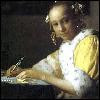 Le Théâtre de l'Ile St Louis is a lovely tiny venue (about 30 seats)you may not see at all if you walk on the Quai d'Anjou by the river for it's located inside of an old builiding, in the depth of an alley.
Le Théâtre de l'Ile St Louis is a lovely tiny venue (about 30 seats)you may not see at all if you walk on the Quai d'Anjou by the river for it's located inside of an old builiding, in the depth of an alley.A musical was showed in there yesterday, Hildegarde de Bingen ou le divin féminin. I knew that, as musicals go, this was not the Broadway-type or the dreadful Canadian style (I have nothing against Canadians but I can't bear the Luc Plamandon's musicals...and most musicals actually). On the small stage there were only a woman and a man, and many weird instruments. The woman, Catherine Braslavski, performed as Hildegard of Bingen; she was singing while sometimes playing drums and dulcimer. At first I wasn't impressed, but her voice slowly raised, filled the room and took me. I forgot all the religious stuff and enjoyed the musical journey.
Joseph Rowe, like many American artists, does everything. He's a musician, a composer, a writer, a translator and an actor. He played various instruments(Oud, Tibetan bowls, darbuka, mbira, tampura) and, between the songs, read or recited texts– extract from Hildegard's books, a letter she received from another abbess, letters she sent to advise and admonish either Frederik Barbarossa or the Pope.
There are extracts from the show on youtube. It is the same show as the one I saw yesterday evening, except that Joseph Rowe spoke in French yesterday. I wish I knew how to get the video embedded here.
Hildegard of Bingen had been forgotten for centuries until she became trendy at the end of the XXth, mostly for her music. I can't say that I care about her spirituality and philosophy much–although it's interesting to see how she managed to avoid being called a heretic at the time and how a few nowadays environmentalists take over Hildegard's veriditas–yes she was a mystic who thought she had visions, but she was also a creative person and a remarkable woman. She and another abbess of the XIIth century, the famous Heloïse, led the way for women like Christine de Pizan; she had balls!
Hildegard of Bingen had been forgotten for centuries until she became trendy at the end of the XXth, mostly for her music. I can't say that I care about her spirituality and philosophy much–although it's interesting to see how she managed to avoid being called a heretic at the time and how a few nowadays environmentalists take over Hildegard's veriditas–yes she was a mystic who thought she had visions, but she was also a creative person and a remarkable woman. She and another abbess of the XIIth century, the famous Heloïse, led the way for women like Christine de Pizan; she had balls!
PS: the picture is a scan of her famous Scivias that I got via the Heidelberg University website to which the title is linked.
PPS: I'd like to own a dulcimer, it's so pretty!


Aucun commentaire:
Enregistrer un commentaire